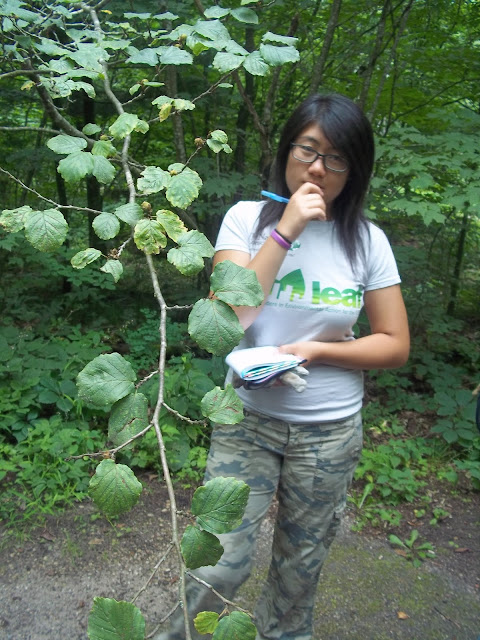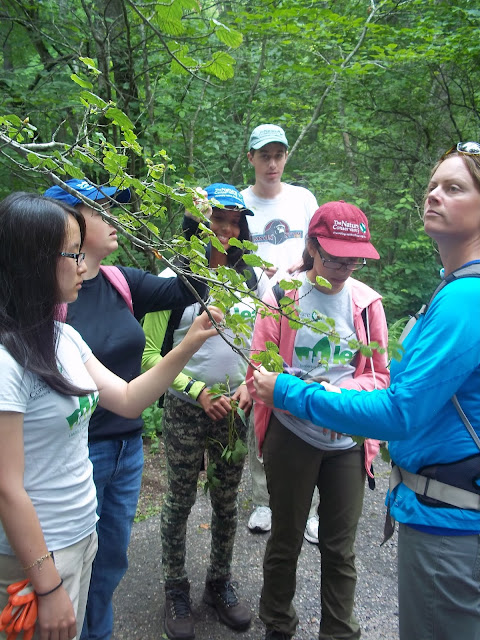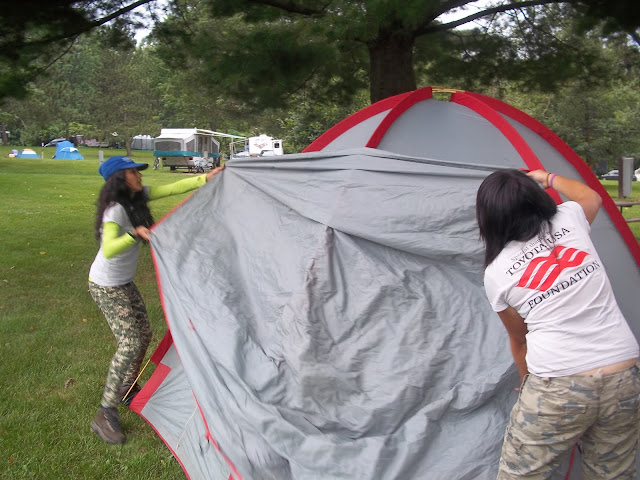Today was the first of the four days of our trip. We woke up extra early to load our car and to meet up with Sarah and the local interns at the office. Here, we picked up our tents for tonight's camping. We drove for about two hours and finally made it to Baraboo, another TNC preserve. TNC owns about 8,781 acres of land here between their 10 preserves in the hills. Ann Calhoun is one of only two people in the Baraboo office! She's the project coordinator ans is in charge of land management needs, conservation easements, speaking with private contractors, and conservation projects. In the picture below Ann is gaving us a brief description of the project she's working on now.
Ann is actually in the process of creating a plan to maintain Oak trees on the preserve because birds prefer them for nesting and resting during their migrations. She also gave a brief introduction of the preserve.

The land owned by TNC is actually fragmented with only one large, combined piece, Baxter's Hollow. TNC began to preserve the area in the 1960s. The eastern end was glaciated and the southeastern end was crashed into what used to be a prairie. This created a unique geology of narrow gorges that allows great diversity of wildlife on the preserve. The gorges allow over 135 species of birds to nest or use the area as a rest stop during migration. Ann explained that the fragmentation of the preserve is a problem, but TNC is definitely trying to work around out. It's mission is to acquire small pieces of land slowly and eventually connect all the pieces, which is how Baxter's Hollow got to be as large as it is today - many small land purchases made over many decades. Ann took us on a hike down Baxter Hollow Gorge.
On our hike, we learned to identify a number of tree species including Ironwood which has paper-like leaves, Witch hazel, and Bass wood.
There were also snakes! We also got to see the damage the flood of 2008 had done to the area. There was so much water that the course of a small stream in the area changed! In the pictures below you can still see some of the wood that was downed during the storm!
A small bridge that used to be over the stream was washed away by the massive flood. While walking, we saw a lot of Baraboo quartzite which is the main rock of the area and allowed the hills to be shaped the way they are. We saw some coverts, fish passages under the bridge, which Nicole from Door County had talked to us about. After our hike, we returned to the parking lot to pull out some huge sweet clover. Some were so large that we needed at least 2 people to pull them out and when that failed we needed to use a clipper.
Once the sweet clover was decimated, we drove up a hill where we ate our lunch and enjoyed an amazing view of the landscape. It looked like a map zoomed up!


After lunch, we said goodbye to Ann, and we went to visit the Aldo Leopold center. The center is on 800 acres that Aldo Leopold had purchased for $647 in 1935. Over the next 13 years the Leopold family worked to restore this devastated farmland to an Oak Savannah planting 1,500 trees a years. The Platinum LEED certified Building of the Aldo Leopold Center was made out of the trees that Leopold's family planted. Small branches that were cut off logs used to make the center, were also used to create paper for a special printing of the Sand County Almanac, Leopolds most well known book. The coolest part to the book is that the paper was created using a brand new environmentally friendly process developed at the University of Wisconsin Madison - instead of using acid a fungus was used to eat the ligens out of the bark and leave the cellulose needed for the paper.
We got to visit the shack that Aldo Leopold and his family used to live in and we got to take a look inside. Most of the furniture and materials that were still in the house were in fact made by Leopold's family. The shack used to be a chicken coop owned by a farmer that previously owned the area. In fact, when we went to the front gate, we learned that the area that is now filled with trees used to be a corn field.





After another unsuccessful crop and with the bank about to foreclose on his property the farmer burned his house down in protest! We got to his what remained of the foundation of the house on our walk. Afterwards, we walked to the Wisconsin River that was near the shack and we saw a bald eagle! We also learned that when Leopold lived at the shack, he only saw 1 sandhill crane, but since his death, 5000 to 8000 cranes migrate to that river each year! We also learned that there are now 16,000 nest pairs of different species of birds living by the river when less than half of that number of nesting pairs were there when Leopold was alive.




When we went back to the Aldo Leopold center, he gave us a small tour of the building. The center was the top LEED certified building in the world when it was first built. It is now second to a building in Dubai we think. He told us about how they save a lot of energy by using special vents to provide heat or cool air from underground that travels through concrete pipelines.
The tables you see in these pictures were also made from trees on the property that the Leopold family planted.
We learned during our tour that at the opening of the center the architects joked that they had used everything from the property but the leaves and needles to make the building. A local glass artist was in the audience and thought that she could do something with them, So throughout the center are these beautiful glass windows created with leaves from trees on the property!
Here you can see the back of the building with its solar panels, large windows for passive heating and lighting and the rain water catchment.
This where the rain water that is captured in fulled and then sent into the prairie created as a rain garden.
Aldo Leopold on his property.
After our tour, we separated from the local interns and went to Devil's Lake to go camping! We built our tents just in time to avoid the rain, and used the time to write our journals!
After it stopped a bit, we attempted to make a fire so we could make pita bread pizzas, but Marissa could not keep the fire going. We had to borrow some lighter fluid and kindling from our friendly neighbors to try to keep the fire going. It still didn't work. But our friendly neighbor saw all the smoke and helped us to keep the fire going - he has the magic touch! Here we are before he came to help trying to block the wind from getting to our little fire!
Afterwards, we made smores and played some night games. One of the games was called Bat and Moth, where one person was blindfolded and had to catch the "moth". After the games, we all went to bed.


































No comments:
Post a Comment